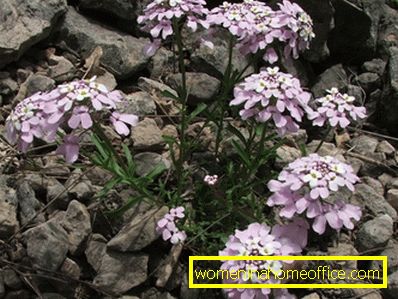Iberis
For the most part, gardeners grow flowers with an exclusively aesthetic purpose. But there are species that are apparently completely unremarkable, but conquer with their smell. It is to such plants can be attributed to beris.
Iberis flowers: photos and varieties
One-year-old Iberis varieties are most interesting for gardeners, if only because of the reduction in the waiting time for their flowering. While perennials in the first year will only settle down, annuals bloom in the same summer. However, they certainly have their flaws. For example, limited varieties.
Iberis umbrella - the most favorite variant in the middle lane of this plant, which came from southern Europe. Flowering begins after 2.5 months. from the moment of landing, usually - in the last decade of June and lasts about 2 months. Interestingly, it can be considered not only a flower, because it has the ability to bear fruit in the form of pods with seeds. Of course, they do not eat them.

The height of the bush can be 40 cm, the stems are actively branching, the leaves are elongated, pointed. The color of flowers varies depending on the variety, only their strong aroma and high density of inflorescences, as well as the plane of their caps, remain unchanged. The most interesting species of umbrellaberis is RedRush (deep scarlet) and GiantHyacinthflowered (pure white flowers like hyacinths).
Iberis bitter- This variety is most often found in the Crimea and southern Russia, although it is getting along well in its other areas. The bush is lower than that of the umbrella, usually does not exceed 30 cm in height. The leaves are less pointed towards the end and have notches at the edge. Flowers can be pure white or with a purple shade. The aroma is bright, the diameter of a single flower is up to 2 cm, the inflorescences are not dense, they resemble a brush. HyacinthblutigeRisen is marked among the varieties available to the middle lane not in the classic white tint - its flowers are in the lilac gamut, and the bush sometimes even reaches 35 cm.

Iberis evergreen - This copy belongs to the category of perennials, and it is most often possible to meet it in the plots in the middle lane. In terms of flowers, it is not very interesting - their diameter is 1.5 cm, the inflorescences, umbrellas bloom only in the 1st decade of June for 20 days.
The value of evergreen Iberis, in addition to aroma, in its leaves that look presentable all year. They, like spruce, do not lose their color. In addition, the length reaches 7 cm. They have a glossy surface. The height of the bush depends on the variety. Dwarf species (10-15 cm) take root in the rocky gardens. Higher (20-25 cm.) Are suitable for beds or bordering lawns.

Gibraltar iberis in the conditions of Russia is especially interesting. Despite the fact that it is also a perennial variety, it does not usually live in the middle lane for more than 2 years. This would be a minus, if not for his ability to self-seeding. The shrub is semi-evergreen, its height is similar to the previous variety - rarely exceeds 25 cm. The color of its colors usually ranges from saturated to pale lilac, although over time they may turn white. On the bush, the flowers are scattered, they do not have such a density of inflorescences as in the Crimean or umbrella species. But cover the greens, they are very thick.
Iberis umbrella: growing from seed
- Umbrella Iberis is very easy to breed: even though it is the southern region. It is not necessary to grow seedlings and only plant them in the open ground for warmth. It is immediately planted where it will live until the cold weather. However, even with such unpretentious behavior, there are certain nuances.
- The soil flower is selected loamy or rocky, well it will take root on the sand. The main requirement here is sufficient air permeability, as well as the presence of light. The darkened areas will not suit unequivocally, he will transfer the penumbra in a short period.
- Growing iberis from seeds is the main way of its reproduction, because, unlike working with cuttings, this technique allows you to do without a step with seedlings. However, it is necessary to wait for relatively warm weather. For the middle band, this is April, when it becomes possible to loosen the substrate well, and the seeds themselves will germinate. Previously, you can do iberis sowing only in the southern regions, where there is no threat to a weak root system in the form of cold weather.
- Seeds are lowered into the loosened soil, not buried, sprinkled with earth and spilled with warm water from a watering can. Scattered watering is necessary to prevent leaching. Shoots should be expected only for 10-12 days, and upon reaching this period begins thinning.
- Given that the bushes grow, it is desirable to make a distance of 15 cm. As they grow, it is likely that you will have to remove some of the seedlings. And since the iberis bloom is short, gardeners recommend sowing it for periods. After 3 weeks after the 1st sowing, a new one is produced. So you can do until the end of July.
- If the seeds are sown on seedlings, it is produced in March, with the deepening of the cups of 1-1.5 cm. In the open ground, young bushes are planted in early May. But here it is easier to track the distance between the saplings, since they have already been bent and formed. It should reach 25-30 cm., So as not to interfere with pollination.
Iberis: planting and care in the open field

If the issue of growing Iberis does not have to be difficult, the moment of caring for it still needs attention. At least for the reason that this plant is subject to both diseases and attacks of pests. And it is better to carry out early prevention, rather than subsequently looking for ways to get rid of parasites and diseases.
First, the main share of care falls on the weak root system of iberis, which is susceptible to various fungi. For example, the cruciferous keel deforms the root, which will affect the growth of the bush and its development. And rizoktoniozosobstvuet rapid decay. To prevent these diseases from inconvenience, it is advisable to periodically disinfect the substrate. If fungus plants appear, remove them immediately. Otherwise, the disease will go to the next.
Secondly, a lot of problems are delivered to iberis and insects. The main pests are aphids and mealybugs, as well as an earthen flea. When the latter appears, the leaves seem to be holed, and in some cases, gnawed around the perimeter. To remove this pest, you need to maintain the correct level of moisture in the substrate: it is better to increase its volume. Cabbage aphid is derived quite simply - the bushes are sprayed with a weak solution of soap and ash. But mealybugs fear only anti-coccidal drugs - they cannot cope with folk remedies.
Care for iberis after flowering

As soon as the plant has finished flowering, it is recommended to prune it. In most cases, iberis organically fits into the flora of the site even with its greenery, which is retained in some varieties only until frost, and in some it lasts all year round. Shortening the bush is enough for 5-10 cm, which will lead to an increase in its compactness.
The end of August - the time of harvesting Iberis. All those bushes that have already faded are removed from the ground by the root, after which they are removed to the closet or to the attic, where maturation occurs. In other words, the seeds reach the state of their physiological ripeness in order to subsequently save them for a new landing. The time required for this process is 2-3 weeks. And any gardener can handle the technology.
Under the ceiling, the ropes are stretched, the floor is lined with paper. Iberis bushes are hung on the ropes so that the roots are looking up. In this form, they will gradually reach the desired state, and the seeds themselves, if they start falling out ahead of time, will be on paper. However, if the summer was dry and hot, the ripening of the cherry will not be necessary: in late August, it will be possible to collect seeds from the bushes without this procedure. It is recommended to store them in paper bags, away from heating devices and excess moisture.
Growing iberis and caring for this flower is quite simple. It does not require special conditions of detention. This plant is not famous for its lush flowering, but for the luxurious delicate aroma that its inflorescences emit. That is why many gardeners appreciate it.